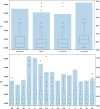Predicting the in-game status in soccer with machine learning using spatiotemporal player tracking data
- PMID: 36175432
- PMCID: PMC9522646
- DOI: 10.1038/s41598-022-19948-1
Predicting the in-game status in soccer with machine learning using spatiotemporal player tracking data
Abstract
An important structuring feature of a soccer match is the in-game status, whether a match is interrupted or in play. This is necessary to calculate performance indicators relative to the effective playing time or to find standard situations, ball actions, and other tactical structures in spatiotemporal data. Our study explores the extent to which the in-game status can be determined using time-continuous player positions. Therefore, to determine the in-game status we tested four established machine learning methods: logistic regression, decision trees, random forests, and AdaBoost. The models were trained and evaluated using spatiotemporal data and manually annotated in-game status of 102 matches in the German Bundesliga. Results show up to 92% accuracy in predicting the in-game status in previously unknown matches on frame level. The best performing method, AdaBoost, shows 81% precision for detecting stoppages (longer than 2 s). The absolute time shift error at the start was ≤ 2 s for 77% and 81% at the end for all correctly predicted stoppages. The mean error of the in-game total distance covered per player per match using the AdaBoost in-game status prediction was - 102 ± 273 m, which is 1.3% of the mean value of this performance indicator (7939 m). Conclusively, the prediction quality of our model is high enough to provide merit for performance diagnostics when teams have access to player positions (e.g., from GPS/LPM systems) but no human-annotated in-game status and/or ball position data, such as in amateur or youth soccer.
© 2022. The Author(s).
Conflict of interest statement
The authors declare no competing interests.
Figures


References
-
- Murray AM, Varley MC. Technology in soccer. In: Curtis R, Benjamin C, Huggins R, Casa DJ, editors. Elite Soccer Players Maximizing Performance and Safety. Routledge; 2019.
Publication types
MeSH terms
LinkOut - more resources
Full Text Sources

